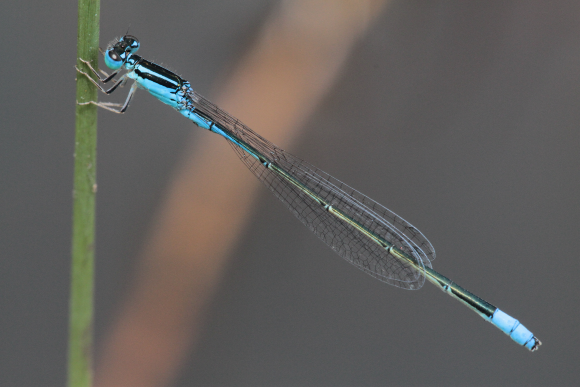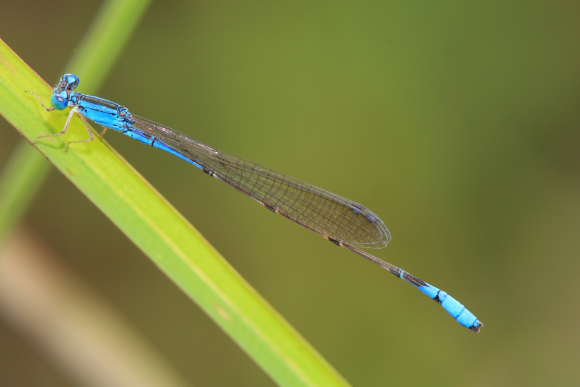Genus Aciagrion Selys, 1891
slims
Synonyms:
- scientific: Mombagrion Sjöstedt, 1909 [gracile]; Ischnuragrion Longfield, 1947 [rarum]; ? Millotagrion Fraser, 1953 [inaequistigma]
Type species: Agrion hisopa Selys, 1876
Introduction
Genus ranges across the tropics of Africa, Asia and Australia with almost 30 species, twelve of them African. They are small to fairly large (hindwing 12-25 mm), very sleek damselflies that are easily confused with Africallagma, differing only in that Cux stands where the anal vein reaches the wing margin, or even proximal to that. Although latter character is generally reliable, the species are diverse in appearance and may move to other genera in the future, e.g. Mombagrion. Most species have very slender abdomen and few dark markings, being pale brownish when young and mostly blue (and sometimes green) with maturity. They favour puddles, pools and marshy patches, often in or near forest, and can be erratic in occurrence. Males may sit on exposed perches such as loose grass far from the edge of rain pools (A. africanum) or fish ponds (A. brosseti). Extensive variation in the extent of black markings and similarities in the appendages make their taxonomy and identification problematic. [Adapted from Dijkstra & Clausnitzer 2014]
Diagnosis
Genus similar to Africallagma by (a) size, Hw 13-20 mm; (b) mesostigmal plates (narrow plate anterior to mesepisterna immediately posterior to prothorax) dorsally with raised flap- or knob-like ridges; (c) humeral stripe at most 2x as wide as antehumeral stripe; (d) Pt in Fw and Hw similarly coloured; (e) Pt pale brown to black, elongate, anterior border longer than proximal border; (f) cerci not branched, often with triangular ventral process (best seen in caudal view); (g) cerci and paraprocts not bifid, latter with dorsal spine but without inferior bulge; (h) base of paraproct usually much swollen, resulting in prominent inferior bulge. However, differs by (1) Cux stands at origin of anal vein, rather than distal from it. [Adapted from Dijkstra & Clausnitzer 2014; this diagnosis not yet verified by author]

Aciagrion steeleae Kimmins, 1955. Male © Jens Kipping

Aciagrion brosseti Legrand, 1982. © Jens Kipping
Map citation: Clausnitzer, V., K.-D.B. Dijkstra, R. Koch, J.-P. Boudot, W.R.T. Darwall, J. Kipping, B. Samraoui, M.J. Samways, J.P. Simaika & F. Suhling, 2012. Focus on African Freshwaters: hotspots of dragonfly diversity and conservation concern. Frontiers in Ecology and the Environment 10: 129-134.
References
- Pinhey, E. (1972). The genus Aciagrion Sélys (Odonata). Occasional Papers of the National Museums of Rhodesia Natural Sciences (B), 5, 1-59. [PDF file]
- Dijkstra, K.-D.B. (2007). The name-bearing types of Odonata held in the Natural History Museum of Zimbabwe, with systematic notes on Afrotropical taxa. Part 1: introduction and Anisoptera. International Journal of Odonatology, 10, 1-29. [PDF file]
- Pinhey, E.C.G. (1964). Dragonflies (Odonata) of the Angola-Congo borders of Rhodesia. Publicacoes culturais Companhia Diamantes Angola, 63, 95-130. [PDF file]
- Pinhey, E.C.G. (1961). Dragonflies (Odonata) of Central Africa. Occasional Papers Rhodes-Livingstone Museum, 1-97. [PDF file]
- Pinhey, E.C.G. (1967). Odonata Zygoptera. Exploration Hydrobiologique Bassin Lac Bangweolo Luapula, 14, 1-43. [PDF file]
- Schouteden, H. (1934). Annales Musee Congo belge Zoologie 3 Section 2, 3, 1-84. [PDF file]
- Longfield, C. 1947. The Odonata of South Angola. Arquivos do Museu Bocage, Lisboa 16: 1-31. [PDF file]
- Schmidt, E. (1951). Libellen aus Portugiesisch Guinea, mit Bemerkungen über andere aethiopische Odonaten. Arquivos Museu Bocage, 20, 125-200. [PDF file]
- Sjöstedt, Y. (1909). Wissenschaftliche Ergebnisse der schwedischen zoologischen Expedition nach dem Kilimandjaro, dem Meru und den umgebenden Massaisteppen Deutsch-Ostafrikas 1905-1906 unter Leitung von Prof. Dr. Yngve Sjöstedt. 14. Pseudoneuroptera. Odonata, 14, 1-52.
Citation: Dijkstra, K.-D.B (editor). African Dragonflies and Damselflies Online. http://addo.adu.org.za/ [2024-10-30].

